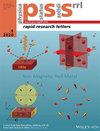黑色硅层的宽波长光散射:珍珠光泽石/硅串联太阳能电池的利润
IF 2
4区 物理与天体物理
Q3 MATERIALS SCIENCE, MULTIDISCIPLINARY
引用次数: 0
摘要
本研究探讨了采用反应离子蚀刻法形成的黑硅(b-Si)层的光学特性(光反射率、吸收率、透射率和散射)。在可见光、近红外和近紫外波长范围(250-1400 nm)内测定了相应的光谱。结果表明,由于纳米针的无序分布,b-Si 层降低了反射率,增加了吸收率和光散射。增加蚀刻时间会加强这种趋势。结果表明,蚀刻 10 分钟的 b-Si 层在波长小于 700 纳米的反射下可被视为完美的光散射体。根据所获得的结果,分析了过氧化物/硅串联太阳能电池中双硅中间层光散射可能带来的益处。结果证明,双硅中间膜不仅能提高底部硅太阳能子电池的有用吸收率,还能提高顶部包晶体太阳能子电池的有用吸收率。研究还展望了未来的研究方向和挑战。本文章由计算机程序翻译,如有差异,请以英文原文为准。
Wide‐Range Wavelength Light Scattering from Black Silicon Layers: Profits for Perovskite/Si Tandem Solar Cells
This study investigates the optical properties (light reflectance, absorptance, transmittance, and scattering) of black silicon (b‐Si) layers formed using reactive ion etching method. The corresponding spectra are determined across the visible, near‐infrared, and near‐ultraviolet wavelength ranges (250–1400 nm). It is demonstrated that b‐Si layers reduce the reflectance, and increase the absorptance and light scattering due to the disordered distribution of the nanoneedles. Increasing the etching duration strengthens this trend. It is shown that b‐Si layers etched for 10 min can be considered perfect light scatterers upon reflection at wavelengths less than 700 nm. Based on the obtained results, the possible profits of light scattering from the b‐Si interlayer for perovskite/Si tandem solar cells are analyzed. It is substantiated that the b‐Si interlayer can increase the useful absorptance not only within the bottom Si solar subcell but also in the top perovskite solar subcell. The prospects for future research directions and challenges are also provided.
求助全文
通过发布文献求助,成功后即可免费获取论文全文。
去求助
来源期刊

Physica Status Solidi-Rapid Research Letters
物理-材料科学:综合
CiteScore
5.20
自引率
3.60%
发文量
208
审稿时长
1.4 months
期刊介绍:
Physica status solidi (RRL) - Rapid Research Letters was designed to offer extremely fast publication times and is currently one of the fastest double peer-reviewed publication media in solid state and materials physics. Average times are 11 days from submission to first editorial decision, and 12 days from acceptance to online publication. It communicates important findings with a high degree of novelty and need for express publication, as well as other results of immediate interest to the solid-state physics and materials science community. Published Letters require approval by at least two independent reviewers.
The journal covers topics such as preparation, structure and simulation of advanced materials, theoretical and experimental investigations of the atomistic and electronic structure, optical, magnetic, superconducting, ferroelectric and other properties of solids, nanostructures and low-dimensional systems as well as device applications. Rapid Research Letters particularly invites papers from interdisciplinary and emerging new areas of research.
 求助内容:
求助内容: 应助结果提醒方式:
应助结果提醒方式:


